
10 Times Japan Made Better Cruiser Bikes Than Americans
The cruiser has always been the prerogative of American brands. When you think ‘cruiser’, a long-stroke, large-displacement v-twin thumping away on a deserted highway comes to mind. This lifestyle has undeniable appeal, bolstered by its rebellious, freedom-seeking portrayal in the media. Cruisers have always sold well as a result. It is a lucrative segment, with fiercely loyal customers and good profit margins to be had. Not just from the products themselves, but from the accessories as well.
By Charles Pennefather Courtesy TopSpeed
It is no wonder that everyone wanted a slice of the cruiser pie. Unsurprisingly, the Japanese got in on the act to make cruisers that the public would want. However, they were shrewd enough to know that a simple copy of the American brands would never do; why would someone get a Japanese imitation of the original product? The Japanese cruisers needed to deliver something that the American brands couldn’t, and boy did they deliver. Here are 10 times the Japanese made better cruisers than the Americans.

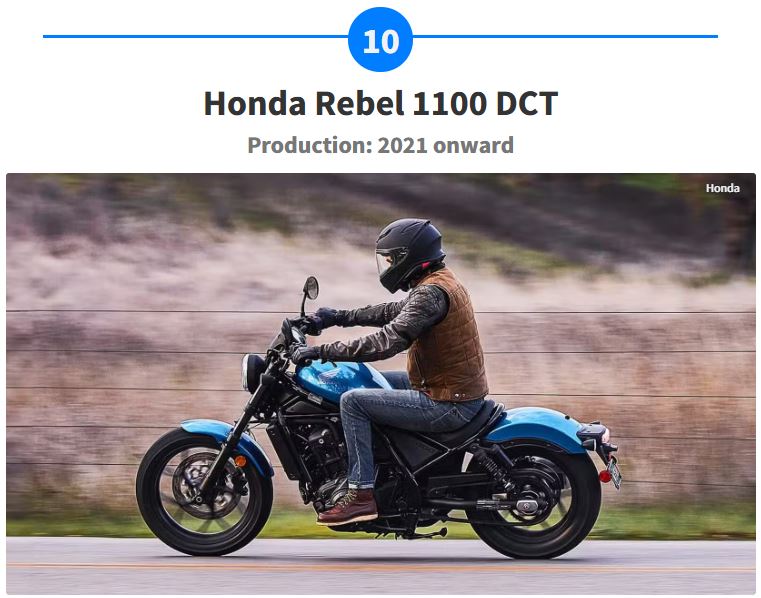
The Rebel doesn’t particularly stand out among motorcycles, to be honest. It is affordable and reliable, and even a beginner can get on one and manage to tame it quickly. However, it does have the honor of being the only cruiser on sale to have an automatic gearbox – and a dual-clutch one at that. The driveline is shared with the Africa Twin DCT but optimized for the cruiser segment, which makes the Rebel a great companion for those learning to ride. Or those who commute a lot on their motorcycle and encounter a lot of traffic. Despite it being on sale for a few years now, there hasn’t been an answer to the Rebel 1100 DCT so far.
|
Engine Type |
270-degree parallel twin, liquid cooling, Unicam SOHC, 4 valves per cylinder |
|
Displacement |
1,084 cc |
|
Max Power |
85.8 HP @ 7,000 RPM |
|
Max Torque |
72.2 LB-FT @ 4,750 RPM |
|
Production |
 2021 onward |

Over two decades ago, Suzuki decided to take on all comers in the cruiser segment with the Boulevard M109R (nee Intruder M1800R). It is the biggest cruiser Suzuki has ever made, with brooding looks and acres of chrome in its first avatars. The engine, despite looking like it is air-cooled, is a completely liquid-cooled unit, and rumor has it that it generated so much torque that the output had to be electronically limited to spare the six-speed gearbox.
Suzuki had to try and tame it with the world’s widest production rear tire on a motorcycle at launch. Today, the M109R is nearly twenty years old and has no electronics other than fuel injection. But it holds its own among the current crop as a value proposition (besides being one of the fastest Japanese cruisers ever). So imagine how good it was when it was first launched!
|
Engine Type |
54 degree v-twin, liquid cooling, 4 valves per cylinder |
|
Displacement |
1,786 cc |
|
Max Power |
123 HP @ 6,200 RPM |
|
Max Torque |
118 LB-FT @ 3,200 RPM |
|
Production |
2006 onward |

Bigger is better, right? In the late 90s, everyone knew it was true, so everyone got busy developing cruiser motorcycles with massive engines. Honda had one with 1,800 cc, Suzuki was working on one with 1,800 cc, and Yamaha had one with 1,700 cc. Then, Kawasaki decided to simply make a motorcycle with the largest displacement twin-cylinder engine in the world. The Vulcan VN 2000 is the result. It looks like the Fat Boy’s larger, corn-fed cousin, but it was as refined as it was heavy. Sadly, it only retained the title of the largest displacement production motorcycle for a very short while it was usurped by the Rocket 3. It remains the largest twin and v-twin production motorcycle to this day, with the largest pistons ever fitted to a production motorcycle.
|
Engine Type |
V-twin, liquid cooling, 4 valves per cylinder |
|
Displacement |
2,053 cc |
|
Max Power |
103 HP @ 4,800 RPM |
|
Max Torque |
130.5 LB-FT @ 3,200 RPM |
|
Production |
2004 – 2010 |
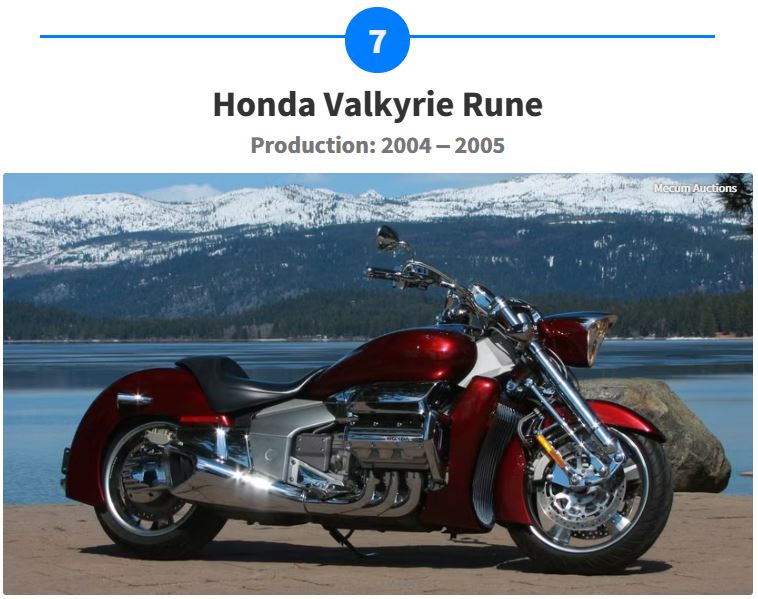
The Gold Wing needs no introduction. But Honda also made a pure cruiser version called the Valkyrie. The Rune was a special edition of the Valkyrie, so its full name is the Honda NRX 1800 Valkyrie Rune. It was built as a showcase of Honda’s capabilities as a manufacturer and sold at an incredible $27,000 at launch.

But it probably cost Honda a lot more than that to produce, since almost all parts were custom-made for it. As a design exercise, it was stunning, with the added bonus of Honda’s quality and reliability. There was nothing on the road like it. Honda pulled it from showrooms in just one year, and we have not seen a proper replacement since.
|
Engine Type |
Boxer six, liquid cooling, SOHC, 2 valves per cylinder |
|
Displacement |
1,832 cc |
|
Max Power |
118 HP @ 5,500 RPM |
|
Max Torque |
120.9 LB-FT @ 4,000 RPM |
|
Production |
2004 – 2005 |
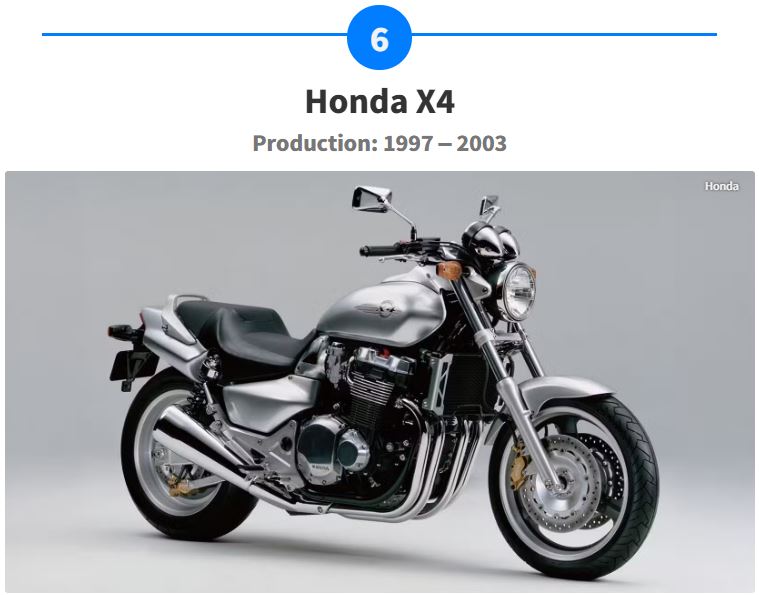
The early 2000s must have been a wild time for fans of Honda cruisers. You could have one with a v-twin (Shadow), a V4 (Magna), a flat-six (Gold Wing/Valkyrie), and then there was this, the X4 with its transverse inline four-cylinder engine. The engine was massaged to power the CB1300, so its reliability and performance were beyond question.
The X4 was intended to compete with the Yamaha V-Max, but sadly, it never made it to the US. It was sold only in Japan in limited numbers, just like the CB1300 Super Four. Honda continues to sell the CB1300 to this day, and it continues to sell it only in Japan. The X4 was discontinued after a mere six years of production.
|
Engine Type |
Inline four, liquid cooling, DOHC, 4 valves per cylinder |
|
Displacement |
1,284 cc |
|
Max Power |
100 HP @ 6,500 RPM |
|
Max Torque |
89.2 LB-FT @ 5,000 RPM |
|
Production |
1997 – 2003 |
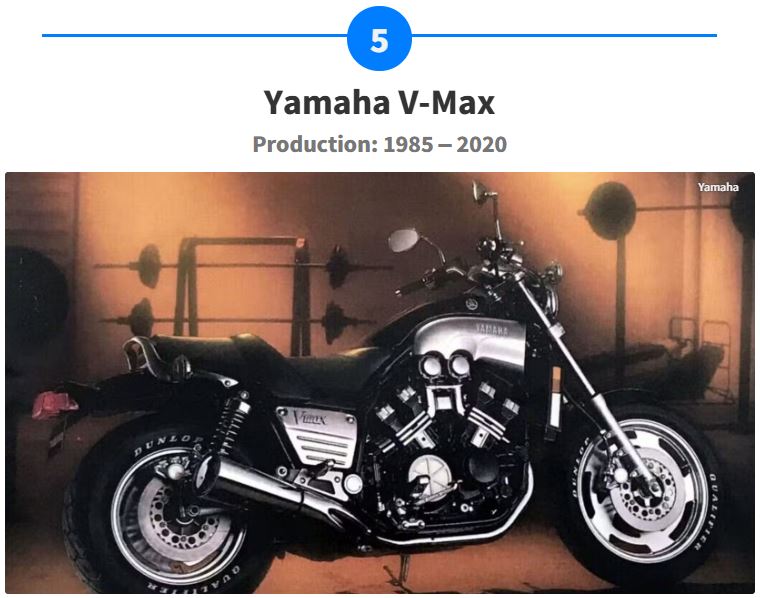
The V-Max was born of a desire to have a model who could partake in the great American sport of drag racing. When the original was launched in 1985, it had truly impressive numbers: 145 horsepower and 83 LB-FT from 1,198 cc and four cylinders. It had a patented V-boost system that opened butterfly valves in the intake to feed more air to the engine at high revs, giving it a higher peak power figure. The second generation, launched in 2009, was even more impressive – a larger engine, more aggressive styling, and a power figure of 200 horsepower. We're yet to see any other cruiser beat this output till date.
|
Engine Type |
70 degree V4, liquid cooling, DOHC, 4 valves per cylinder |
 Displacement |
1,679 cc |
|
Max Power |
200 HP @ 9,000 RPM |
|
Max Torque |
123 LB-FT @ 6,500 RPM |
|
Production |
1985 – 2020 |
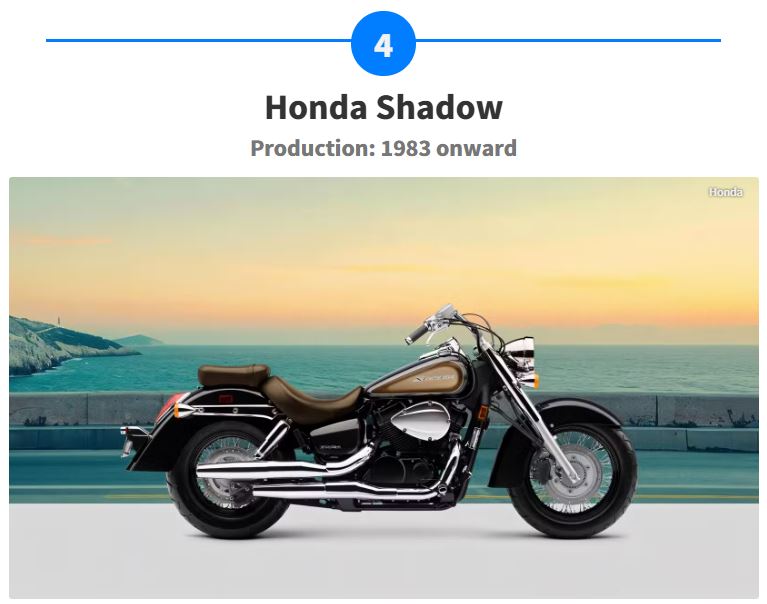
The Shadow series of cruisers sit above the Rebel series in Honda’s pecking order and has always had a v-twin engine. In its current form, it has a liquid-cooled engine that looks air-cooled, with the right looks for an American cruiser. But with Honda’s attention to detail and engineering prowess. Shadows have had engines displacing anything from 125 cc all the way to 1,099 cc, all of which were v-twins. Drive went to the rear wheel either by chain or shaft, and it is sold to this day in a 750cc version.
|
Engine Type |
52 degree v-twin, liquid cooling, SOHC, 3 valves per cylinder |
|
Displacement |
745 cc |
|
Max Power |
45 HP @ 5,500 RPM |
|
Max Torque |
47.9 LB-FT @ 3,500 RPM |
|
Production |
1983 onward |
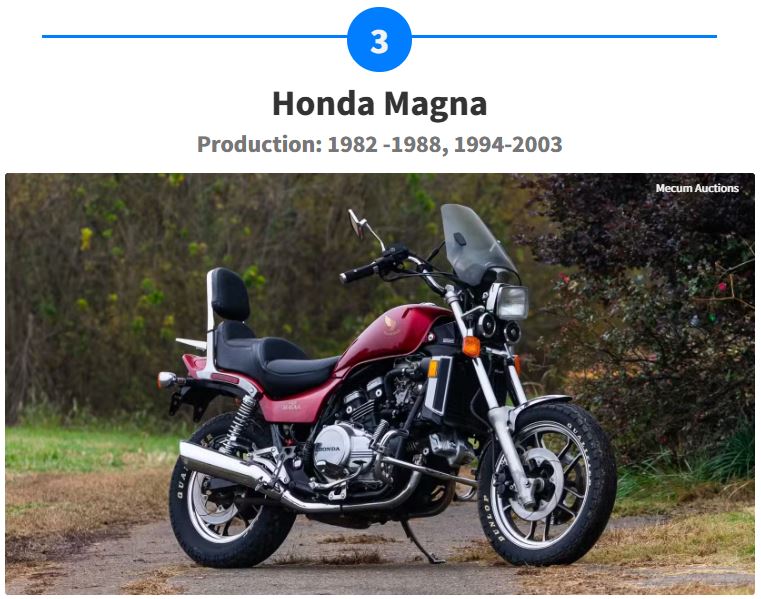
The V-Max might be the most famous V4-powered Japanese cruiser. But the Honda Magna predates it by a few years. Honda used a 90-degree liquid-cooled V4 with a shaft drive for the Magna, and displacements ranged from 500 cc all the way to 1,098 cc (for the V65 Super Magna). This particular model was one of the fastest production motorcycles of the time, being clocked by independent testers at 140 MPH. The Magna’s defining styling element was the quad upswept exhaust pipes, two to a side, present on the 1987 year model.
|
Engine Type |
90 degree V4, liquid cooling, DOHC, 4 valves per cylinder |
|
Displacement |
748 cc |
|
Max Power |
200 HP @ 9,000 RPM |
 Max Torque |
123 LB-FT @ 6,500 RPM |
|
Production |
1985 – 2020 |
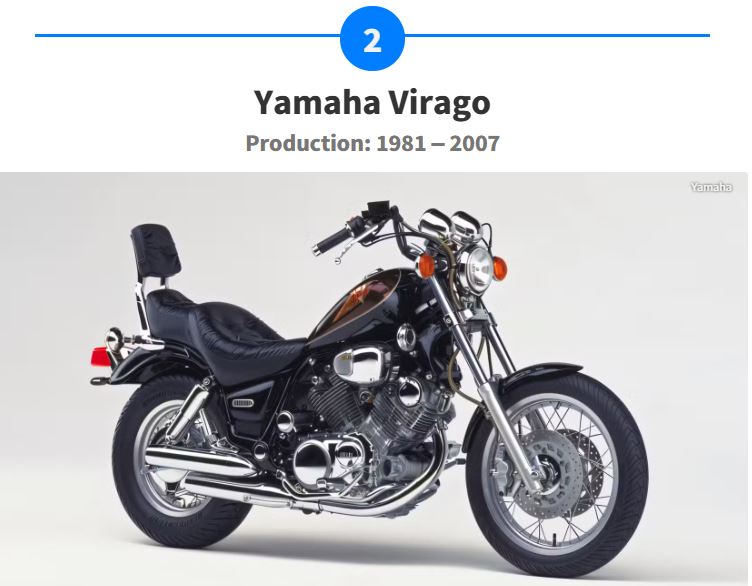
The Virago was a range of v-twin cruisers manufactured by Yamaha for well over a quarter of a century. It is important because it gave rise to Yamaha’s Star range of motorcycles, including the V-Star and Road Star branded motorcycles, some of which were genuine Harley-Davidson killers. The Virago was Yamaha’s first cruiser with a monoshock rear suspension, something that American cruisers even today choose to eschew in favor of old-school twin rear shocks. Like all Yamahas, it handled really well for a cruiser and was a great motorcycle for an enthusiast.
|
Engine Type (535 Virago) |
70 degree v-twin, air cooling, SOHC, 2 valves per cylinder |
|
Displacement |
535 cc |
|
Max Power |
44 HP @ 7,500 RPM |
|
Max Torque |
31 LB-FT @ 6,000 RPM |
|
Production (all Viragos) |
1981 – 2007 |
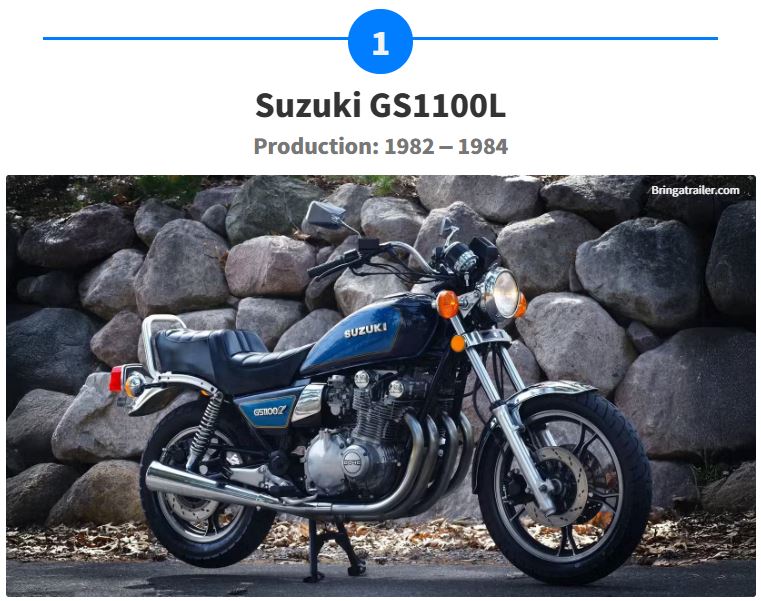
Suzuki had a GS series in the 80s. It was the manufacturer’s first four-stroke lineup of motorcycles. If the GS range sounds familiar, well, it evolved to become the GSX series of motorcycles. Suzuki chose to fit the GS series with liquid-cooled engines as well, which gave them consistent performance under varying conditions. The 1100 was the flagship, and the GS1100L and GS1100GL were the cruiser versions of the street bike. While Honda and Yamaha were offering V4s in their power cruisers, Suzuki offered customers an inline-four that was based on a sweet-handling street bike. Quite a potent combination.
|
Engine Type |
Inline four, liquid cooling, DOHC, 2 valves per cylinder |
|
Displacement |
1,074 cc |
|
Max Power |
92 HP @ 8,000 RPM |
|
Max Torque |
64 LB-FT @ 7,000 RPM |
|
Production |
1982 – 1984 |
Disclaimer:
As a service to the sport we all love and follow, Biker Life posts numerous media releases from a wide variety of sources on our website. Due to the large number, and sometimes short time available, it is nearly impossible to review each public release. These articles are written by reporters, writers or press officers who work for various organizations, event organizers, teams, drivers, riders, and other parties, and they do not necessarily reflect the opinions of Biker Life.
